Expert Care for Opal Jewelry: A Complete Guide
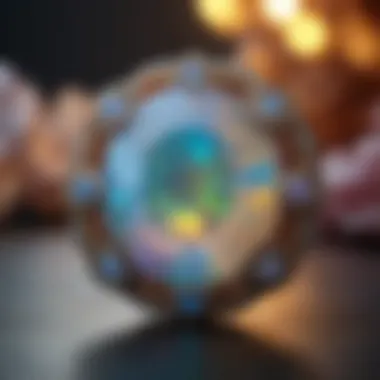
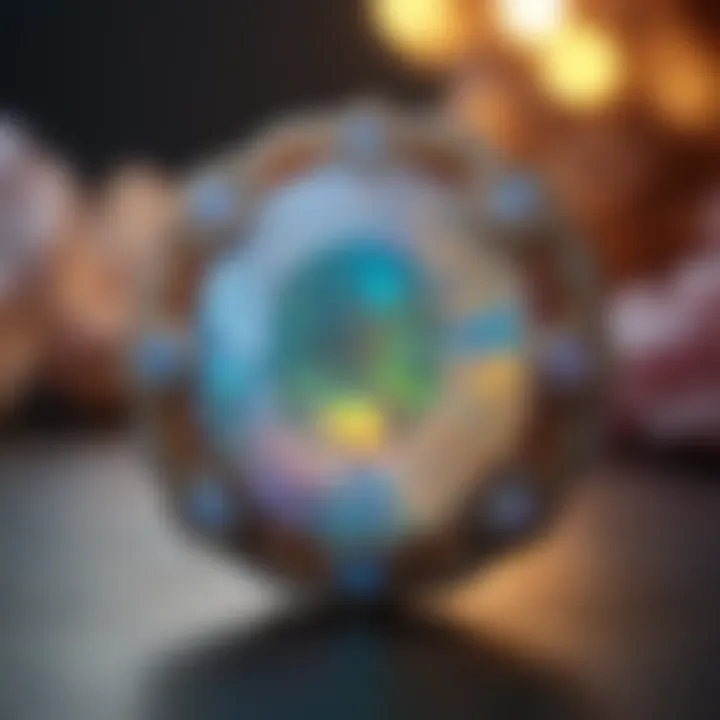
Intro
Caring for opal jewelry can be a delicate endeavor, given these gemstones' unique characteristics. With their vibrant play of color and delicate structure, opals require a thoughtful approach to maintenance. Understanding these aspects can prevent damage and ensure that these exquisite pieces remain beautiful for generations. Whether you are a novice gemstone enthusiast or a seasoned collector, knowing how to properly care for opal jewelry is essential.
Gemstone Overview
Definition of Gemstones
Gemstones are precious or semi-precious stones that have been cut, polished, and used in jewelry making. They are prized not just for their beauty but also for their rarity. Opals fall into the category of semi-precious stones, distinguished by their remarkable optical phenomena known as play-of-color. This term refers to the shifting hues that occur as the stone is moved, a feature that sets opals apart from others like diamonds or rubies.
Classification of Gemstones
Gemstones can be broadly classified into two categories: precious and semi-precious. Precious stones include diamonds, sapphires, emeralds, and rubies, while semi-precious stones encompass a wider range, including lapis lazuli, amethyst, and of course, opals. Within these categories, opals are further classified into several varietals:
- Black Opals: Known for their dark body and vibrant colors.
- White Opals: Characterized by a milky background.
- Boulder Opals: Contain ironstone, giving them unique patterns.
- Crystal Opals: Transparent with vibrant colors, often sought after for their clarity.
Each type requires different care, especially considering their various structures and durability.
Historical Significance
Origins of Gemstone Use
The allure of gemstones isn't a modern phenomenon. Throughout history, cultures around the world have embraced gemstones for their beauty and metaphorical significance. Opals, in particular, date back to ancient civilizations, where they were often seen as symbols of purity and hope. The first known use of opals can be traced back to ancient Romans who adored these gems not only for their color but also believed in their magical properties that could enhance the wearer's health and fortune.
Cultural Insights: Gemstones in Ancient Civilizations
In antiquity, opals were revered in many cultures. The ancient Greeks considered opals to be a gift from the gods, believing they bestowed foresight and prophetic powers. Similarly, in Arabic culture, opals were thought to be the tears of the gods, said to fall to earth from the heavens. These associations with divine favor and spiritual protection contributed to the opal's desirability and significance through the ages.
"Opals are not merely stones; they are pieces of history, capturing the reverence of civilizations long gone."
Thus, understanding the historical context enhances our appreciation of opals, transforming how we care for them today. Awareness of their past helps to reinforce the importance of treating these stones with the utmost respect.
As we continue through this article, we will explore the best practices for maintaining your opal jewelry, providing an in-depth roadmap to ensure its longevity and brilliance. Careful attention to opals' specific needs can preserve their striking beauty and allow them to remain cherished treasures.
Understanding Opal as a Gemstone
Opals are not just jewels; they are pieces of earth’s artistry, encapsulating ethereal beauty and complexity. Understanding the foundational aspects of this gemstone is critical for anyone involved with opal jewelry, whether you’re a collector, a designer, or simply an enthusiast. It sets the stage for the care and keeping of these precious pieces. A well-rounded appreciation of opals helps in making informed choices about their maintenance and enjoyment.
Historical Significance of Opals
Opals have been cherished since ancient times. The Romans dubbed them as a symbol of hope and purity, while others associated them with good fortune and protection. Cultures worldwide have intertwined opals into their lore; for example, the Australian Aboriginals regarded them as creation stones, believing that the gods sprinkled them across the earth. The mystique surrounding opals, bound in tradition and superstition, adds depth to their worth as gemstones. This history enriches the experience of wearing opal jewelry, instilling a sense of connection to the past.
Unique Characteristics of Opals
What truly distinguishes opals is their play-of-color, a phenomenon that can take your breath away. This iridescence arises from microscopic silica spheres that diffract light, creating a stunning array of colors. Each opal has its own character, influenced by geological conditions and the environment it was formed in. Due to their amorphous structure, they are unique compared to other gemstones, blessing each opal with an unpredictable dance of hues. For those who appreciate individuality, opal stands apart in the jewel community.
Types of Opals
Understanding the various types of opals is crucial for anyone looking to care for these gems properly. Each type comes with its unique traits, which influence both aesthetic and maintenance aspects.
Natural Opals
Natural opals form over millions of years through the accumulation of silica deposits in water-filled gaps of rocks. They are celebrated for their authenticity and natural beauty. Because they haven't been subjected to treatments, natural opals maintain a certain charm, making them highly sought after by collectors. Their vulnerabilities, however, mean that proper care is essential, especially when it comes to cleaning and storage.
Advantages of natural opals include their unique patterns and colors, which can’t be replicated in synthetics. Each one tells a story – a blend of nature’s artistry and time.
Doublets and Triplets
Doublets and triplets offer a creative twist on the classic opal. They consist of a piece of opal layered with a backing of another material (like black onyx for contrast), often enhancing color visibility. This layering allows for a more affordable option while still showcasing the appealing play-of-color that opals are known for. However, their synthetic nature may require more careful handling, especially to prevent peeling or separating. They can be a boon for those who desire a striking look without the heavy price tag.
Boulder Opals
Boulder opals are unique as they retain a portion of the host rock. This distinctive feature not only gives them unique character but also enhances their strength compared to other opals. Found primarily in Queensland, Australia, they often display exciting patterns intermingled with ironstone. Their beautiful, rugged look holds appeal for those seeking both beauty and durability. While they may demand a tad more maintenance due to their rough edges, their breathtaking patterns make them worth the effort.
White, Black, and Crystal Opals
White, black, and crystal opals embody their own enchanting qualities. White opals, with their lighter base tone, often showcase brilliant colors, while black opals – admired for their depth and intensity – usually demand a higher price due to their rarity. Crystal opals, semi-transparent and luminous, showcase vibrant colors against their clear backdrop. Each type carries unique characteristics that influence wearing and caring practices. For example, black opals might require extra care to protect them from scratches, whereas white opals need careful cleaning to maintain their luster.
The Vulnerabilities of Opal Jewelry
Understanding the vulnerabilities of opal jewelry is crucial for any gem enthusiast. Opals, despite their beauty, have unique characteristics that require special attention. Recognizing these vulnerabilities enhances your ability to protect your cherished pieces from wear and tear. Failing to understand these aspects can lead to irreversible damage, making it important to be proactive in your care regimen.
Susceptibility to Scratches
Opals are not the toughest cookies in the gemstone world. Their Mohs hardness typically falls between 5.5 and 6.5, meaning they can be easily scratched by harder materials like quartz or even metal. This susceptibility makes it vital to be mindful of how you handle and store your opal jewelry.
- Practical Tips:

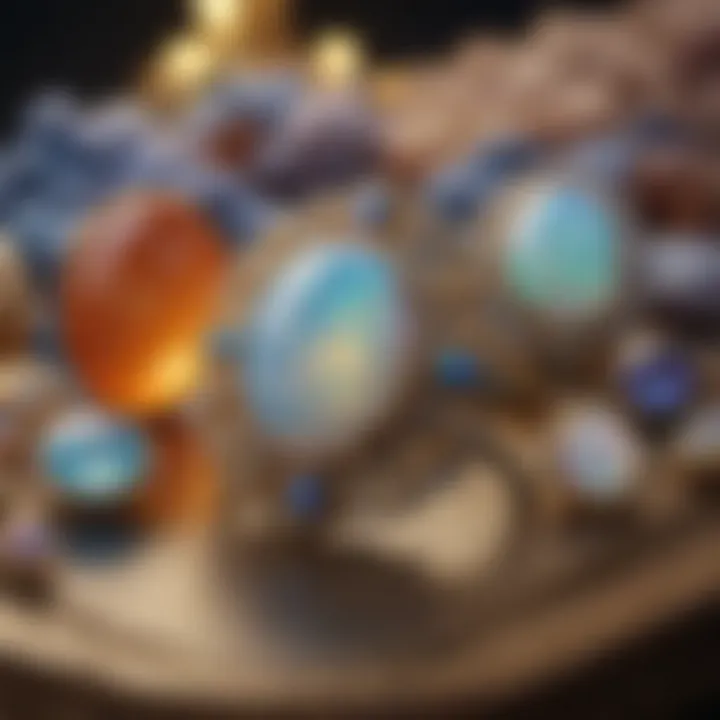
- Avoid contact with other jewelry. Store your opals separately in soft pouches or lined compartments to prevent scratching.
- Wear with caution. Take off your opal rings or necklaces when engaging in activities that might expose them to abrasive surfaces.
To put it bluntly, treating your opals like a prized possession rather than just another piece of jewelry will extend their life and beauty.
Impact of Temperature and Humidity
Opals are particularly sensitive to temperature fluctuations and humidity. They contain water—up to 20% in some varieties—which makes them vulnerable to drying out. When subjected to extreme heat or low humidity, the delicate structure of an opal can crack or even break apart.
- Why It Matters:
- Sudden temperature changes can lead to thermal shock, causing fractures.
- High humidity, while generally better than low humidity, can still affect the gemstone's integrity if the environment is not controlled, potentially leading to mold or fungi if it's stored improperly.
A steady environment with controlled temperatures and humidity levels is ideal for maintaining the luster and integrity of opal jewelry.
Chemical Sensitivity
Opals are not fans of harsh chemicals. Many common household substances, such as perfumes, lotions, and cleaning agents, can wreak havoc on these delicate gems. The porous nature of opals allows these chemicals to seep in, possibly leading to discoloration or dullness over time.
- Best Practices:
- Remove jewelry before applying personal care products.
- Clean with care. Use only gentle soaps and warm water, avoiding any abrasive cleaners or solvents.
Always remember: avoiding exposure to chemicals is one of the simplest ways to preserve your opal's vibrant colors.
In summary, being aware of the vulnerabilities associated with opal jewelry opens doors to better protection and care strategies. Whether it’s limiting exposure to scratches, controlling environmental conditions, or avoiding harsh chemicals, every step contributes to the longevity and beauty of your treasured opals.
Cleaning Opal Jewelry: Best Practices
Taking care of opal jewelry is not merely about aesthetic upkeep; it’s a crucial element to preserving the beauty and longevity of these exquisite gemstones. Opals, with their unique play of color and delicate structure, require special attention during cleaning. Regular cleaning helps remove dirt and residue that can dull the stone’s luster. Additionally, understanding the right methods and timing ensures that your opals stay vibrant for years to come.
When to Clean Opal Jewelry
Cleaning your opal jewelry should be approached with an eye for detail. A good rule of thumb is to clean your pieces after several wears, particularly if you’ve been in environments that could accumulate grime, such as cooking or working with your hands.
Many experts recommend a scheduled cleaning plan every few months, especially for daily wear items. However, if you've noticed any discoloration or dullness, it might be time to take action sooner. It never hurts to check for possible damage like scratches or cloudiness that might signal it’s time for some TLC.
Recommended Cleaning Methods
Using Mild Soaps
When it comes to cleaning, using mild soaps is your safest bet. These soaps are gentle yet effective, ensuring that your opal’s surface remains undamaged. With sodium oils or harsh chemicals off the table, a simple mixture of warm water and a few drops of mild dish soap will suffice. Not only does this method prevent scratching, but it also preserves the opal’s hydration, which is essential since some opals have a water content that can get compromised by harsh agents.
Soft Cloth Cleaning
Soft cloth cleaning is an essential part of maintaining your opal jewelry. Using a soft, lint-free cloth, you can gently wipe away any environmental residue or oils that might have clung to the stone. This method minimizes the risk of causing any abrasions. It also holds the dual benefit of being a quick way to keep your opal shining brightly in between deeper cleans.
Avoiding Ultrasonic Cleaners
While ultrasonic cleaners seem like a modern quick fix, they are a big no-no for opal jewelry. These devices use high-frequency sound waves to remove dirt but can cause cracks or chips on opals due to the gemstone's sensitivity. Sticking to manual cleaning methods, particularly with warmth and care, is always preferable. This approach safeguards your stones from being compromised in any way.
Tools for Effective Cleaning
Soft Brushes
A soft brush can do wonders when cleaning intricate jewelry settings. Its bristles can reach tight spaces, ensuring every nook is free from dirt. When used gently, it supports a thorough clean without causing harm. A toothbrush with soft bristles can suffice in many cases, but ensure it’s clean before getting to work. This tool is a must-have for any serious opal enthusiast.
Microfiber Cloths
Microfiber cloths, known for their absorbent and non-abrasive quality, offer an excellent cleaning option. They effectively lift dust and debris without scratching the opal’s surface. Whether used damp or dry, their versatility makes them a popular choice for gemstone cleaning. With their fine fibers, they can capture particles that regular cloth would miss, keeping your opal as stunning as the day you bought it.
Proper care of opal jewelry not only enhances their physical beauty but also extends the life of treasured pieces.
Storing Opal Jewelry Safely
Caring for opal jewelry does not stop after you clean it; how you store these precious gems plays a pivotal role in their longevity and beauty. Opals, known for their stunning play of colors, require a particular touch in terms of storage. An improper storage environment can lead to scratches, chips, or even cracks. By investing time and thought into how you store your opals, you can avoid headaches down the line.
Ideal Storage Environment
When it comes to storing opal jewelry, the environment is everything. A stable temperature and moderate humidity are crucial. Fluctuations in these factors can stress the gemstone, potentially leading to cracks or other damage. Ideally, store your opal jewelry in a place where temperature remains consistent, away from places that experience high heat, like direct sunlight or near heating vents.
The relative humidity should be in the range of 40% to 60%. Too much moisture can encourage mold growth, while too little can dry out the opal, possibly affecting its vibrant colors. A closet in a climate-controlled part of the home often works well, provided it doesn't have any chemicals that can harm the stone.
Choosing the Right Storage Solution
Jewelry Boxes
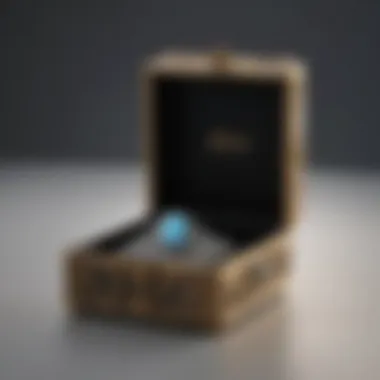
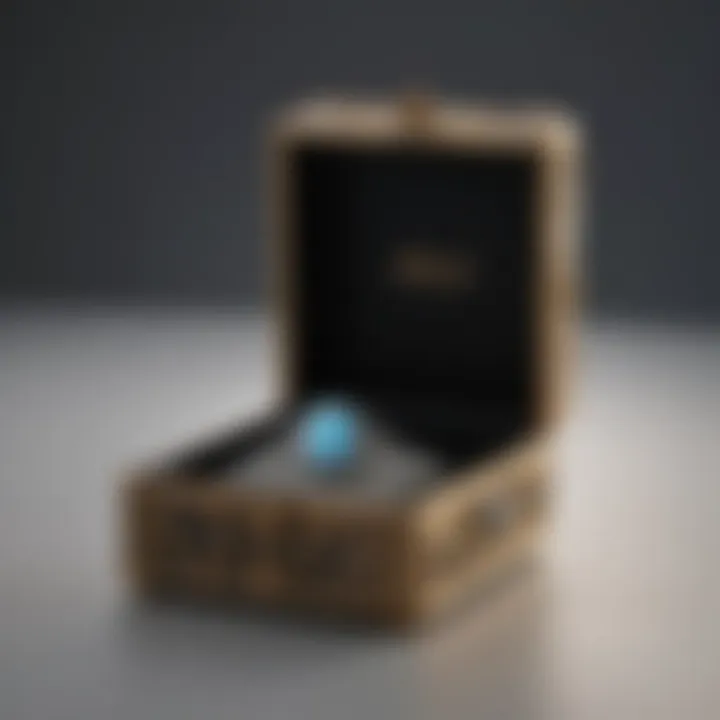
Jewelry boxes can do wonders for storing opal pieces. They are often lined with soft fabric material, helping to provide a cushion that minimizes the chances of scratches when pieces move around. One of the key characteristics that make jewelry boxes a favored choice is their compartmentalization; it allows you to segregate different pieces, reducing the risk of tangles or accidental damage.
It's essential to keep the box closed and in a cool, dark place. However, boxes can sometimes trap moisture, so ensuring good airflow is important to avoid any humidity build-up.
Soft Pouches
Soft pouches are another excellent storage solution for opal jewelry. These alternatives are lightweight and often made from fabrics like velvet or satin, which provide excellent protection without putting pressure on the gems. Their standout feature lies in portability; you can easily carry individual pouches when traveling.
Moreover, these pouches are generally better at preventing scratches compared to harder storage options. That being said, they do lack the rigid protection that jewelry boxes offer, which means they might not be the best option for long-term storage without some care and attention.
Avoiding Damage During Storage
To avoid damage during storage, consider the following practices:
- Avoid cascading items: Do not stack jewelry on top of each other, as this can lead to scratches or other types of damage.
- Separate storage: Keep opals stored separately from other gemstones. Diamonds, for instance, can scratch softer opals.
- Routine checks: Periodically check on your stored jewelry to ensure that they haven't sustained any unnoticed damages.
- Control your climate: Be vigilant about humidity levels in your storage environment; consider using silica gel packs to absorb excess moisture.
"The way you store your opals echoes louder than their beauty. Protecting them is half the battle in keeping their allure alive."
By paying attention to these simple practices, you can preserve the exquisite nature of your opal jewelry for years to come. Proper storage isn’t just helpful—it is essential for the continued enjoyment of these remarkable gemstones.
Wearing Opal Jewelry: Tips for Longevity
Wearing opal jewelry requires a level of mindfulness that goes beyond mere aesthetics. The unique characteristics of opals, which make them stunning, also render them susceptible to various forms of damage. Understanding how to wear opal jewelry can not only enhance its beauty but also ensure its longevity. It’s about marrying enjoyment with care, striking a balance that allows gemstone enthusiasts to showcase their treasures while protecting them from potential detriment.
Situations to Avoid when Wearing Opals
Active Pursuits
Engaging in active pursuits while wearing opal jewelry can lead to mishaps. Activities such as sports, gardening, or any labor-intensive task expose the jewelry to bumps, drops, and scratches. Opals are softer than many gemstones, often ranking around 5.5 to 6.5 on the Mohs scale of hardness. This vulnerability means that rigorous physical activity can result in chips or abrasions, not to mention the risk of the piece becoming dislodged altogether. The clumsiness that sometimes accompanies such pursuits makes it a wise idea to leave opals behind during high-impact activities.
Exposure to Chemicals
The realm of chemicals is another lurking danger for opal jewelry. Many household products, from cleaning agents to hair sprays, contain substances that can tarnish or degrade opals. The porous nature of this gemstone means that it can absorb these chemicals, leading to discoloration or even structural weakening. A prime example is chlorine—often found in pools—that can wreak havoc on opal’s integrity. When considering the wearability of opal jewelry, understanding the subtle but impactful nature of chemical exposure is crucial, serving as a guiding principle in its care.
Seasonal Considerations
Different seasons bring about various environmental factors that affect opal jewelry. Heat and humidity during the summer can cause the opal’s moisture content to fluctuate, possibly leading to issues like crazing or cracking. Conversely, the biting cold of winter can make the gemstone more brittle. It's advisable, then, to be mindful about wearing opals depending on the season. For warmth-loving opals, wearing them in milder conditions can prolong their vibrant appearance while mitigating risks associated with extreme temperatures.
"Understanding and respecting the unique needs of opal jewelry helps preserve its vibrant beauty and ensures that it remains a beloved piece in your collection."
Each of these tips underscores a vital aspect of caring for opal jewelry while enjoying its charm. By being proactive in avoiding damaging situations, gemstone enthusiasts can extend the life of their precious opals and keep them looking their very best.
Repairing Damaged Opal Jewelry
Caring for opal jewelry often involves addressing wear and tear that can occur over time. Understanding the repair process is crucial as it not only helps maintain the beauty of the gem but also preserves its sentimental and monetary value. Damaged opals can lose their sparkle and brilliance, leaving the wearer feeling dissatisfied. By knowing how to repair these exquisite gems, you ensure their longevity and continued enjoyment.
Identifying Types of Damage
Before diving into the repair process, it's vital to pinpoint the type of damage your opal may have suffered. Two common issues are cracking and chipping, and loss of opacity.
Cracking and Chipping
Cracking and chipping in opals often occur due to sudden impacts or temperature fluctuations. It's not uncommon for these delicate gems to be subjected to a day in the life that requires them to endure knocks and bumps. A crack, particularly, can disrupt the gem's clarity and overall aesthetic.
For a gemstone enthusiast, the key characteristic of cracks and chips lies in their visibility. Unlike other types of damage, which might be minor, these issues can greatly affect the opal’s refractive quality. This issue is prevalent given how often people wear opals in daily life.
The unique feature of a crack is its potential to lead to further damage if not addressed promptly. Once a crack appears, it may expand or lead to pieces chipping away. Therefore, one might find it beneficial to develop a keen eye for this type of damage. Catching these issues early can save both time and cost in the repair process, ultimately prolonging the enjoyment of this beautiful stone.
Loss of Opacity
Loss of opacity in opals can sometimes be an indication that the gemstone has been subjected to excessive exposure to moisture or chemicals. The opal's luster is one of its defining features, and when it diminishes, so too does the piece's appeal.
This issue serves as a reminder of the delicate nature of opals. A visible drop in opacity can detract from its hypnotic play of color, which is the hallmark of opal jewelry. For enthusiasts, maintaining that vibrant look is crucial and, hence, loss of opacity is worth careful monitoring.
A unique feature in this case is that loss of opacity may not necessitate physical repairs; sometimes, a good cleaning or proper restoration techniques suffice. However, watchful care is essential as opacity loss could signal deeper underlying issues that might require professional attention.
Professional Repair vs. DIY
When it comes to repairs, there’s always a tussle between opting for professional help or trying to tackle it oneself. While DIY might sound appealing, especially for minor issues, it doesn’t come without risks. An experienced professional can ensure that the integrity of the opal is maintained and that repairs are aligned with industry standards. On the other hand, taking a DIY route might lead to further damage if not done correctly.
Thus, weighing the pros and cons of each route can help in deciding the best course of action for your opal. Self-repairs can sometimes save money, but confronting the intricacies of opal repair calls for a skilled touch to keep these precious stones looking luxurious.
"Regular maintenance and timely repairs can greatly enhance the lifespan of opal jewelry, making the investment worthwhile."
In the end, repairing damaged opal jewelry requires careful assessment and a clear understanding of different damage types. Whether one decides to go for professional repair or a DIY approach, keeping a well-draining eye on what’s occurring with these gems ensures enjoyment for years to come.
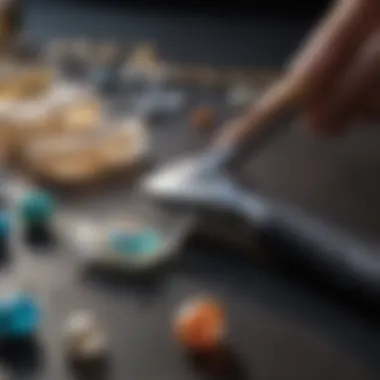
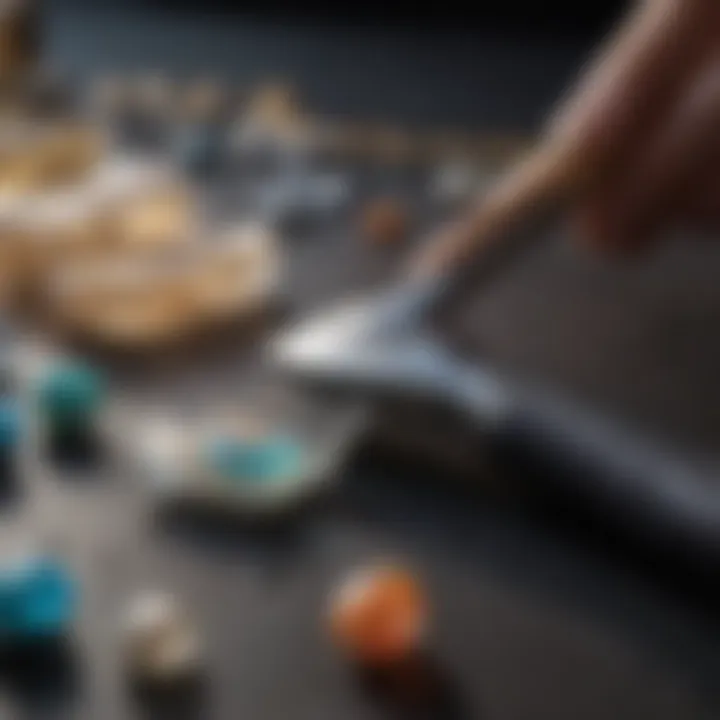
Maintaining Opal Jewelry Over Time
Caring for opal jewelry is a long game. Unlike other gemstones, opals require consistent attention to maintain their iridescence and structural integrity. This section sheds light on the nuances of long-term maintenance for your cherished opals, ensuring that they not only stay beautiful but also remain functional over years or even decades. Without proper care, even the most stunning piece can lose its allure, so letting it gather dust isn't an option. Investing in good maintenance not only preserves their beauty but can also positively influence their value.
Regular Inspections
It is wise to conduct regular inspections of your opal jewelry. Much like clocks that need winding or vehicles that need oil changes, regular check-ups on your gems can reveal unnoticed issues before they escalate. Here are a few tips to consider:
- Look for Visible Damage: Check for signs of chipping, cracking, or discoloration. If you notice any, it may be time to consult a professional.
- Check the Settings: Ensure that prongs holding the stones are secure. Loose settings can lead to loss, which would be quite unfortunate.
- Look for Loose Beads or Stones: If your piece is a necklace or bracelet, gently shake it to see if any beads or stones clink against each other. You don’t want a surprise when you realize a stone is missing.
Establishing a routine for inspections—say, every three to six months—can save your jewelry from potential disasters. Remember, the eyes are the windows to the soul, and in this case, they help in assessing the health of your opal jewelry too.
Reconditioning and Restringing
Over time, the threads of your opal jewelry can wear down, just like a favorite t-shirt that gets plenty of use. This reconditioning serves not only aesthetic purposes but also practical ones, preventing breaks and losses. Here’s a straightforward guideline to follow for this meticulous task:
- Assess Wear: Regularly check the cords or threads to see if they show any signs of fraying or fading.
- Timing is Crucial: If a necklace or bracelet is worn often, consider restringing it every year. It’s much easier to prevent an issue than fix it after the strands have snapped.
- Choose Quality Material: When reconditioning, opt for durable materials that suit the weight and size of the opals. Silk is a classic choice, but there are high-strength alternatives available as well.
Taking a few moments to recondition and restring gives your jewelry a new lease of life. Think of it as a spa day; your opals will sparkle just a bit more after.
*"An ounce of prevention is worth a pound of cure." This is especially true when it comes to opals. Regular care now prevents costly repairs later on."
Whether you’re a newcomer to the world of opals or a seasoned collector, understanding how to maintain these unique gems is fundamental. Keeping an eye on their condition and being proactive can help preserve your investment while enabling you to enjoy their unparalleled beauty for a lifetime.
The Role of Professional Care
Caring for opal jewelry goes beyond just occasional cleaning and storage; it involves a deep understanding of the gemstone’s vulnerabilities and the best practices for maintaining its beauty. This is where the role of professional care becomes paramount. Expertise in gemstone care ensures that opals are treated delicately and effectively, safeguarding their vibrancy and allure over the years.
Seeking professional help isn’t a luxury; it’s often a necessity. Opals can easily be damaged due to their unique composition, and therefore, entrusting them to a skilled jeweler offers peace of mind to the gem enthusiast.
Moreover, establishing a relationship with a qualified jeweler introduces a layer of accountability and trust in the care of one’s treasured pieces. Let's look into how to find such a jeweler and the diverse services they provide.
Finding a Qualified Jeweler
When it comes to opal jewelry, finding a qualified jeweler should be at the top of your list. Not all jewelers have the same level of expertise in handling sensitive gemstones. Look for someone with a solid reputation, preferably one who specializes in colored gemstones or opals specifically.
- Ask for Recommendations: Start by asking fellow enthusiasts, friends, or local gem clubs for suggestions.
- Research Online: Websites such as Reddit or jewelry forums can offer valuable insights about trusted jewelers in your area.
- Visit in Person: A visit can reveal a lot about a jeweler. Check their craftsmanship, ask questions about their experience, and don’t hesitate to inquire about their affinity towards opals.
Once you’ve found a few candidates, check their certifications and education in jewelry repair and gemstone handling. Professional memberships, such as being part of a recognized gemological organization, can also indicate a commitment to quality and training.
Services Offered by Professionals
Once you identify a skilled jeweler, you will likely find that they offer a myriad of services tailored specifically for opal jewelry.
Cleaning and Polishing
Cleaning and polishing are essential aspects of professional care when it comes to opal jewelry. Dirty opals can lose their charm, and improper cleaning methods can even worsen their condition. Jewelers employ specialized techniques that gently remove grime without harming the delicate surfaces.
The beauty of professional cleaning lies in its thoroughness; they can reach nooks and corners that are typically missed during at-home efforts. For opals, where the surface luster is key, a skilled touch can restore the vibrancy safely.
However, there's a unique trick of the trade—using soft solutions that avoid chemicals harmful to the opal’s structure is crucial. That's why this service is not just beneficial; it’s essential for maintaining the integrity of your jewelry while reviving its natural sparkle.
"Proper maintenance can never be an afterthought, especially when it comes to porous stones like opals."
Repair and Restoration
Repair and restoration go hand in hand when maintaining opal jewelry. A qualified jeweler can address issues like cracks or chips, which can occur from wear and tear or accidental injury. Restoration work not only involves fixing visible damage but also ensuring that the stone's unique structure remains intact.
The advantage of professional repair is the expertise that comes with years of training. They can assess the extent of damage and provide solutions that might not be apparent to untrained eyes. For example, a jeweler may use resin to fill cracks in a way that enhances the stone’s clarity and doesn’t detract from its original beauty.
Of course, this service isn’t without its considerations; costs can add up depending on the severity of the repair, but the longevity it provides makes it a worthwhile investment.
In summary, professional care is not just about upkeep; it is about creating a supportive partnership that ensures the lasting beauty and integrity of your opal jewelry. Understanding the roles and services professionals offer allows gem enthusiasts to make informed choices, preserving these exquisite pieces for generations to come.
Closure: Upholding the Beauty of Opals
In the context of caring for opal jewelry, the conclusion ties together the myriad of considerations and practices discussed throughout this article. Opal gems are not just pieces of jewelry; they are precious, vibrant works of art that require an understanding of their unique properties and vulnerabilities.
First and foremost, maintaining the beauty of opals demands a commitment to regular care. Unlike more durable gemstones, opals can be sensitive to changes in temperature, humidity, and chemicals. Thus, developing a habit of routine inspections can help identify emerging issues early. This approach keeps opals looking their best and extends their lifespan significantly.
Furthermore, the cleaning and storage methods discussed earlier are crucial. Proper storage solutions, such as soft pouches or specialized jewelry boxes, can protect these gems from unnecessary scratches and damage. It’s not just about putting them away; it’s about ensuring they remain intact and ready to wear or admire.
"An opal's beauty lies not just in its appearance but in the care it receives throughout its life."
This highlights the notion that, as with any precious item, opals thrive with attention and respect.
Moreover, when faced with damage, knowing when to seek professional assistance can make a world of difference. Professional jewelers can provide invaluable services not only in cleaning but also in repairing and restoring opal jewelry. DIY fixes might be tempting, but they can often lead to more significant problems. A prudent approach includes balancing self-care with professional input.
Finally, the impact of understanding these factors on both novice and experienced collectors cannot be overstated. Gemstone enthusiasts of all levels can benefit from this knowledge, ensuring their opals remain treasured heirlooms rather than mere artifacts. By embracing both the beauty and fragility of opals, we uphold their allure and charm for generations to come.
In summary, caring for opals is an ongoing journey deeply rooted in appreciation for their unique characteristics. This article provides a roadmap for every gem lover to navigate that journey, ensuring that these dazzling gems continue to spark joy wherever they are worn or displayed.



